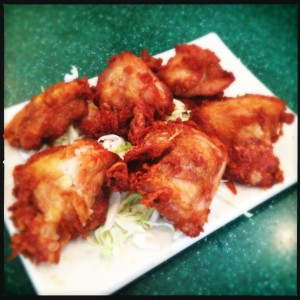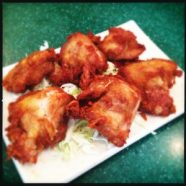Ramen Ya: the Good, the Bad, the Greasy (Maui Now)
 Dining at Ramen Ya in the Queen K mall started off a little more like a double-dog dare than a promising enterprise.
Dining at Ramen Ya in the Queen K mall started off a little more like a double-dog dare than a promising enterprise.
Ominous phrases like “noodles in dirty dishwater,” and “it’s a carb carnival and the protein isn’t invited” were tossed about, proving the dare-makers aren’t just mean… they’re quite witty.
Never one to back down from a bad bet or inadvisable gamble, sail was set for Ramen Ya.
We started with the Mochiko Chicken ($5.50). The six pieces of breaded, boneless thigh meat were greasy, fatty, crunchy, kind of sweet – and really good.
Maybe it was just gnawing hunger or a general weakness for a deep fryer, but the chicken hit the spot. Is it health food? Hells no.
But go into it knowing this is no lean cut of bird, and you’ll be more than satisfied.
The Mapo Tofu Ramen ($8.50) was interesting.
Usually that word is employed as a euphemism for “ick,” but we actually do mean interesting.
Ma Po Tofu is typically a spicy Chinese dish made with tofu, pork, fermented black beans and Sichuan peppercorn.
This is that – sort of – but presented as a soup.
One gets the sense a packaged Ma Po Tofu mix is stirred into a broth.
Some of the usual suspects – ground pork and silken tofu – make an appearance and to fulfill that “carb carnival” promise, Japanese ramen noodles are along for the ride as well. The dish has a kick and a slow after-burn.
It’s inventive. We’ll give them that. Maybe we’ll see other traditional Chinese American dishes reinvented in soup form soon: Chop Suey Chowder? General Tso’s Bisque?
The mind boggles.
The Seafood Fried Udon’s ($9.75) accompanying picture showed a strange and serrated (presumably) sea-based item. Thankfully, what showed up was an insanely generous portion of thick udon noodles stir-fried with fish, shrimp, cabbage, carrots, and bean sprouts…and no weird squiggly stuff whatsoever.
The udon is crazy good with that unique wok flavor that only comes from a well-used pan. It would be a viable offering in any mainland Chinese restaurant. Once again, it’s not quite Chinese nor Japanese, but it works.
You may find yourself thinking about these noodles over and over again in the days hence.
(I miss you, Udon Noodles. Call me?)
The Miso Ramen ($7.95), however? Not so much.
You can taste the miso, but it is not of very high quality. The accompanying meat is a single, thin, grimy slice of pork. The piece of kamaboko (that peppermint-looking fellow) fish cake at least adds a festive look. Minus a scattering of green onion on top, there are no vegetables to be found and the dish has an overarching muddy flavor.
All in all, there’s a yuck factor we couldn’t quite put our finger on. Pass.
The Wonton Ramen ($8.50) was acceptable. The broth had a strong shoyu flavor profile. Once again, the slice of pork was there and no vegetables made the cut. The dish would have benefited from some carrots, bean sprouts, cabbage… anything.
The wontons themselves are somehow greasy, with a small little pellet of pork inside. This is a better option than the miso, but not by much.
All around the restaurant is stark evidence of prepackaged assistance. Clearly visible in the kitchen are dozens of unopened boxes of Golden Curry. Stacked high by the soda machine are a variety of instant Asian classics like Nongshim Bowl (a Korean brand) noodle soup in kim chee flavor.
Without hesitation, the soups are the weakest offering and maybe that’s because they’re seemingly all pre-made in a factory, put on a boat, and reconstituted at the Queen K mall. Feel free to draw your own conclusions, but we recommend sticking with the options that don’t come in a broth.
What should you order then?
Well, if you weren’t already swayed by the praise heaped upon the Seafood Udon, consider the Seafood Crispy Noodle ($9.75).
Once again, a monster portion is delivered, enough that there will be plenty left for an entire dinner the next night.
Unlike the soups, this dish arrived thick with carrots, cabbage, shiitake mushrooms, shrimp, and fish.
The noodles are hard at first, but soften under the oyster sauce-based gravy as they sit. It’s the half-brother of the beloved house cake noodle sans mussels or beef, but every bit as good.
If you find yourself at Ramen Ya between the hours of 3 and 5 p.m., it’s “happy hour” and each meal receives an accompanying side of Gyoza ($2.50 with a meal when it’s not happy hour). The four gyoza taste like the kind you buy at Costco and are filled with cabbage, pork, and ginger. They’re traditionally fried on one side and steamed on the other. Hey, they’re free. Otherwise? Maybe come another time when they’re free.
Ramen Ya is what it is: a small mall restaurant with great prices, large portions, and an alarming stack of prepackaged food boxes. Service is efficient and friendly. If you’re in the mood for Chinese-meets-Japanese-meets-Korean Hawaiian-style comfort food and now feel empowered to choose wisely, some of it is truly comforting.






